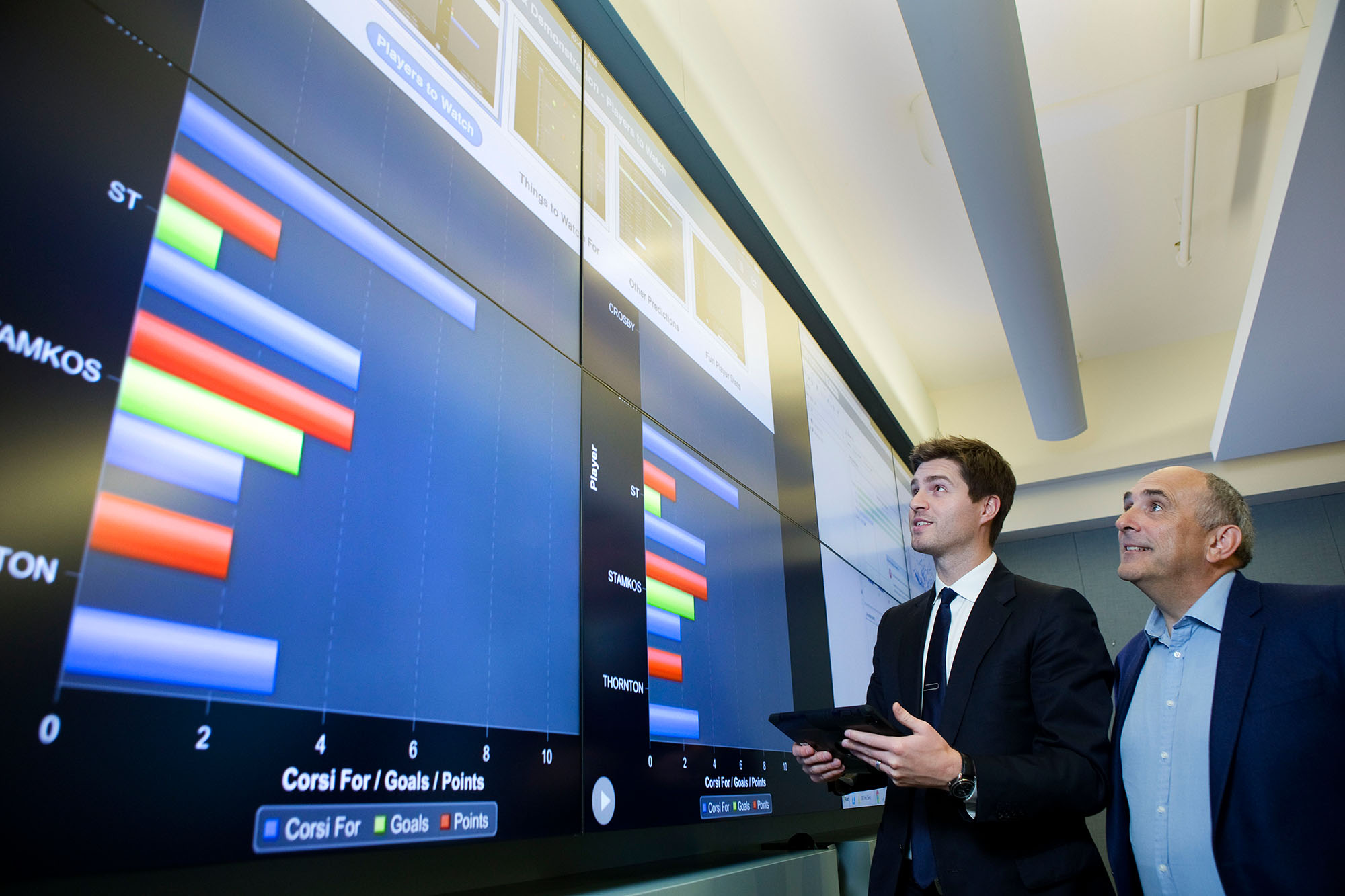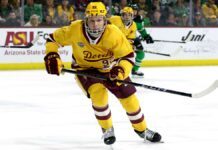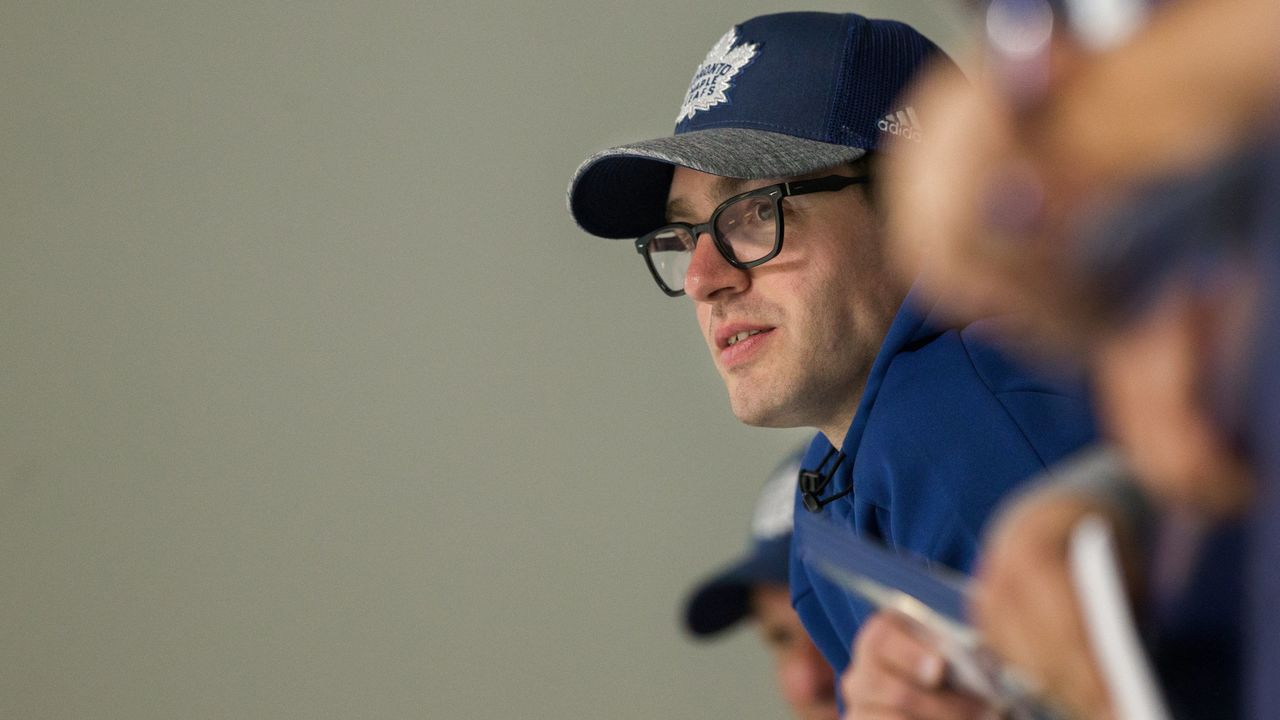The NHL salary cap may be going up more than expected next season. That news, plus the approach of the Seattle expansion, will feed into future trade decisions.
Let’s take a look at what it might mean for Kyle Dubas and his capologist, Brandon Pridham.
#NHL cap projection for 2020-21: $84 to $88.2 million, up from current $81.5 million, but it’s dependent on negotiations with NHLPA.
— Frank Seravalli (@frank_seravalli) March 4, 2020
That range of $84M to $88.2M is really wide. For teams close to the salary cap, the final number could have a big impact on a team’s offseason plans.
What to Expect

Why is there such a wide range and why can’t they set it now?
It relates back to the CBA. The lower end is based on a zero percent inflator while the upper end of $88.2 million is based on the maximum five percent inflator. The NHLPA has the right to invoke an inflator in that range.
Last year, the NHLPA reacted to chronic membership complaints over escrow, the way in which part of the player’s paycheque can be held back until the players’ 50% share of actual full season hockey-related revenues is worked out by bean counters. It’s an ongoing internal debate within the NHLPA: A higher escrow hold-back hurts players already signed to contracts for next season, whereas a lower escrow is created by limiting salary growth, affecting upcoming free agents more.
By lowering the rate of growth of the salary cap, the NHLPA could reduce escrow, and that’s what the NHLPA chose to do — they reined in the inflator to just one percent a year ago. That’s why the salary cap only rose 2.5%, from $79.5M to $81.5M for the 2019-20 season. It was a full $1.5M lower than what Gary Bettman estimated at the December Board of Governors meeting.
Because of the binding CBA agreement with the NHLPA, it took until June 22nd, 2019 for the new salary cap to be announced. That surprisingly small year-over-year increase so close to the draft, contract decisions, and July 1st caused problems for a lot of teams. As a result, GMs were left to quickly adjust their roster, trade, and free-agent plans.
On the very day of the salary cap announcement, Kyle Dubas made a major trade aimed at seeking cap relief, sending a first-round pick to Carolina as compensation for taking on the final season of Patrick Marleau’s $6.5M contract. Days later, in a time crunch with offer sheets threatening, Dubas signed Kasperi Kapanen and Andreas Johnsson to new deals. We all will recall how ridiculously close Toronto came to the new cap by the end of the summer once Mitch Marner was inked to a $10.893M deal.
The fallout from last year’s salary cap announcement has now prompted discussions between the NHL and NHLPA on a more timely and stable salary cap planning process. That can only be good for the game, but for now, teams may have to live with the prospect that a final salary cap for 2020-21 might not be announced until late June again. I suspect that teams will be more conservative in their plans this time around.
What does this mean for the Toronto Maple Leafs?

Imagine how skeptical GMs will be when looking at that $88.2M upper limit. These Charlie Browns have seen Lucy pull the football away at the last minute before. While I would love to imagine and play around with an $88.2M salary cap, I think that’s unlikely. The NHLPA chose a one percent escrow last year and I suspect GMs will use that as their “best bet” scenario for this year. That works out to $84.8M. For these purposes, let’s call it $85M. (It’s still entirely possible that the cap moves higher, perhaps to $86M, but I’ll stick with $85M for now.)
Let’s break down what Kyle Dubas might do with that extra pocket money.
According to CapFriendly, the Leafs currently have 18 players and $77.8M committed for next season. With an $85M salary cap, that leaves $7.2M available to add another 2-5 players (active NHL rosters have to be between 20 and 23) . Now that we see the projected salary cap range, signing Jake Muzzin and Pierre Engvall to extensions when they did looks even smarter.
Barring trades, the Leafs have three full forward lines signed up for next season, and they appear to be very close to what we could expect for a top-nine forward group. They also have three defensemen signed up who can play a top-four role (Rielly, Muzzin, and Holl). We can debate whether Holl is a number four, five, or six defenseman longer-term, but let’s put him there for now.
Committed $85M Roster
A. “From Within” Baseline Scenario
First, let’s see how well we can build an $85M roster for next year without making any trades. Understanding this roster helps set the stage for planning changes.
Travis Dermott, an injured Ilya Mikheyev, Frédérik Gauthier, and recently-acquired Denis Malgin are unsigned RFAs. Tyson Barrie, Cody Ceci, Kyle Clifford, and Jason Spezza are pending UFAs.
Based on their play this season combined with the extensions to Holl and Muzzin, as well as their likely contract demands, I’m going to make the assumption that Barrie and Ceci are not going to be offered new contracts.
I’ll also make rough early guesstimates on new deals for Dermott (2 x $2.3M), Mikheyev (1 x $1.5M), Spezza (2 x $0.8M), and Gauthier (1 x $0.7M). I have a lot of uncertainty around Dermott right now — mostly that the contract could range higher.
The rental, Kyle Clifford, may be on the bubble, simply because his full salary was $1.6M this year ($800K paid by Leafs). I think a raise could make him too expensive for the Leafs bottom six, but in this “from within” roster exercise, let’s try to make it work and offer him 2 x $1.8M simply because he brings something the Leafs need (a physical presence). If that’s not enough, or he doesn’t perform well enough, the Leafs can choose to go with lower-cost options.
I assume Denis Malgin is a depth signing and he may or may not be signed in the off-season, similar to Nic Petan the year before. Malgin would require a $787,500 qualifying offer and he has arbitration rights. Egor Korshov is a right-winger who could well be called up from the Marlies next season, he is waiver exempt, and he would cost $925K against the cap. I’ve excluded him from the roster below, but I suspect he could join the team at some point next season, especially if a winger is traded or injured.
“From Within” Roster
Here’s what the “From Within” roster looks like with the above assumptions.
Although it is a competitive roster for 2020-21, it’s not without familiar concerns. Here are my takeaways:
- The main loss is RD Tyson Barrie to free agency. Despite his defensive weaknesses, he is still a valuable offensive defenseman and Colorado absorbed half of his $5.5M cap hit this season. That isn’t easy to replace on a dollar-for-dollar basis.
- The main strength of this homegrown roster is the continued quality and depth of the forward roster, especially if relatively healthy next year.
- The right side defense still looks risky. Justin Holl has made a major move up the lineup this season, but it’s a risk to have him in a top shutdown pair spot. This roster depends on Travis Dermott moving to the right side in a top-four role. I haven’t seen enough of him playing well in the top four, let alone playing on the right side, to be confident he would succeed. It also assumes Rasmus Sandin can handle a third-pairing role — that looks reasonable, although he still needs to develop defensively. Even with Dermott moving over, the right side defense remains a major question mark.
- I’m also not sure Timothy Liljegren will be NHL-ready at the start of next season, so Calle Rosen (or possibly even Martin Marincin) is a distinct possibility (Rosen has played the right side before).
Roster Construction and the Seattle Expansion Draft

This may sound a little like four-dimensional chess, and I might be diving a little too deeply again (I see you all nodding knowingly). But at least it gives us a sense of some of the complexities involved behind building a roster and considering a trade.
Before looking at rebalancing the forward/defense strength, the June 2021 Seattle draft implications have to be understood. The draft will only allow the Leafs to protect seven forwards, three defensemen and one goaltender (I’m simplifying).
Forwards
First, it’s most likely that the seven protected forwards will be Matthews, Tavares, Marner, Nylander, Kapanen, Johnsson, and Kerfoot. You may wonder about Hyman and Mikheyev. They don’t require protection.
Zach Hyman is scheduled to be an unrestricted free agent on July 1 next year. As long as Hyman isn’t extended until, say, June 23rd next year (the day after the expansion draft), Seattle will avoid selecting him.
Ilya Mikheyev could theoretically be eligible for the expansion draft because players with three or more professional seasons are eligible, and Ilya played his four previous seasons for Avangard Omsk in the KHL. European leagues like the KHL do count, but the kicker is Article 10 of the CBA specifies they only count if a player is under an NHL Standard Player Contract (SPC) at the time. Mikheyev was not signed to an SPC, so he is exempt from the draft.
Therefore, the projected top-nine forwards in the “From Within” Leafs roster are safe from the Seattle expansion draft.
The first choice on the remaining exposure list would likely be Engvall. Clifford, Spezza, and Gauthier would round out the forward options for Seattle. Prospects such as Nick Robertson and Egor Korshkov are exempt. Jeremy Bracco is eligible, but at this time, I don’t see Seattle taking a flyer on him despite his strong 2018-19 season.
If an offseason trade should happen, including one of Johnsson, Kapanen, or Kerfoot would have the additional benefit of allowing Engvall (or another preferred forward like Clifford) to be added to the seven forward protection list. Including Hyman or Mikheyev in a trade would not. That’s something the Leafs will be well aware of.
Defensemen
The three expansion-protected defensemen in the “From Within” roster would be Morgan Rielly, Jake Muzzin, and one of Travis Dermott or Justin Holl. I think many would choose to protect Dermott given his age and evidence of improving defensive skills, but exposing an older Holl could prove costly also. He is a big, low-cost, right-handed defenseman who has shown an ability to play in the top four alongside Muzzin when needed.
The March SKATR profiles show just how difficult a decision that could be. The good news is that Seattle can only pick one of them if given the chance.

Top prospects Timothy Liljegren and Rasmus Sandin are exempt because they do not have three qualified professional seasons. Again, there is a quirk in the CBA criteria and Kyle Dubas knowingly backed his truck up to that gate when he decided to develop Liljegren and Sandin on the Toronto Marlies:
Article 10.2: “For the purposes of this Section 10.2(a), a Player aged 18 or 19 earns a year of professional experience by playing ten (10) or more NHL Games in a given NHL Season, and a Player aged 20 or older (or who turns 20 between September 16 and December 31 of the year in which he signs his first SPC) earns a year of professional experience by playing ten (10) or more Professional Games under an SPC in a given League Year.”
Basically, their U20 AHL professional seasons do not qualify because they had not played 10 or more NHL games in those seasons.
Summing Up the Seattle Risk
Seattle could scout and window shop Pierre Engvall, Kyle Clifford, and Justin Holl before deciding to pick Jack Campbell since only one goalie can be protected. No offense to Jack Campbell, but there are plenty of backup options that would be available next June and Campbell would be down the list.
My crystal ball right now says that Holl is the most likely selection by Seattle followed by Engvall. They have some very bright new analytics staff, so you can be sure they will make a smart choice. That is unless Dubas offers up a sacrificial lamb. We’re still a year away, but I wanted to emphasize the Seattle risk to the Leafs defense.
Acquiring a Right Defenseman

We need to start by recognizing that the cup is half full. The Leafs have been improving structurally in many areas — greater forward depth, growth of the young core led by Auston Matthews and William Nylander this season, improved backup goaltending with Jack Campbell, improvements to the left side of the defense with Jake Muzzin and Rasmus Sandin, the removal of anchor contracts, and the alleviation of LTIR restrictions going forward.
However, the homegrown roster I reviewed and the Seattle expansion possibilities probably left you with a gnawing hunger to do something more about next season’s right side defense. A right side led by Holl and Dermott is a risky bet. Let Seattle take one of them away, and the risk is even greater.
You may also have a deeper appreciation of how little space is available to make a big free-agent splash, even with an $85M salary cap. To really improve next year’s roster, it will take a trade. Space will need to be freed up.
Last year, Kyle Dubas arrived at similar conclusions. His actions were to create space by moving Marleau, remove a long term anchor in Nikita Zaitsev, and trade away a forward piece (Kadri) for a right-handed defenseman (Barrie). The Barrie trade, as it turns out, only underlined the fact that the Leafs have and still need a more balanced top-four defender on the right side. Barrie has been a top-pairing offensive player and a third-pairing defensive player. That was not an ideal fit.
If a top-four RD is acquired either through free agency or trade, the Leafs depth chart suddenly looks much more like a serious contender, one that can withstand the pressure of playoff hockey and the league’s best attacks. It also allows players like Liljegren to develop at a more proper pace.
That RD unicorn is what motivated me to write a series of articles before the trade deadline, assessing the trade value of Leafs players like Johnsson, Kapanen, and Engvall and trade targets like Josh Manson, Matt Dumba, Dylan DeMelo, and Brenden Dillon.
The upshot of my Seattle analysis is that the Leafs are more likely to lose another defenseman after next season. The defense structure is vulnerable as it stands. If the Leafs are to protect only three defensemen, it makes sense to me that those three have to be loaded as much as possible with future team value. Rielly and Muzzin will do that, but I’m not sure using the last defenseman protection slot to keep Dermott and lose Holl has the same impact. It sounds closer to a 50/50 choice.
That is the dilemma that I believe Kyle Dubas faces right now: Can he acquire a right-handed defenseman who is protection-worthy and worth losing Dermott or Holl to Seattle?
The Leafs General Manager does have tools in his kit to go looking for bigger fish. He can include one of the forwards I mentioned above. It looks like Seattle protection status, the depth chart, and current contracts combine to point to Johnsson or Kapanen as the most likely candidates. He can also include one of Dermott or Holl (because he will likely lose one to Seattle anyway). Even Liljegren should not be untouchable (although I believe he would be undervalued right now in a trade).
What makes this next offseason even more intriguing is that there will be defense-rich teams seeking to trade their fourth-best defenseman prior to Seattle before they lose them for nothing (or paying a King’s ransom to protect them). If the Chinese Farmer was told “too bad about Seattle,” he would respond with a “maybe.”
https://t.co/1f4yr9jEu0 https://t.co/z2qq2ws7Nz
— Kyle Dubas (@kyledubas) February 26, 2020





















![Two Down, Two to Go for the Maple Leafs – MLHS Podcast EP91 [Now with Video]](https://mapleleafshotstove.com/wp-content/uploads/2025/04/maxresdefault-3-218x150.jpg)











